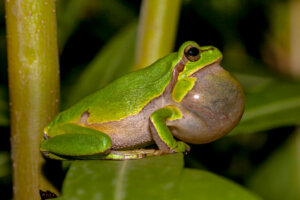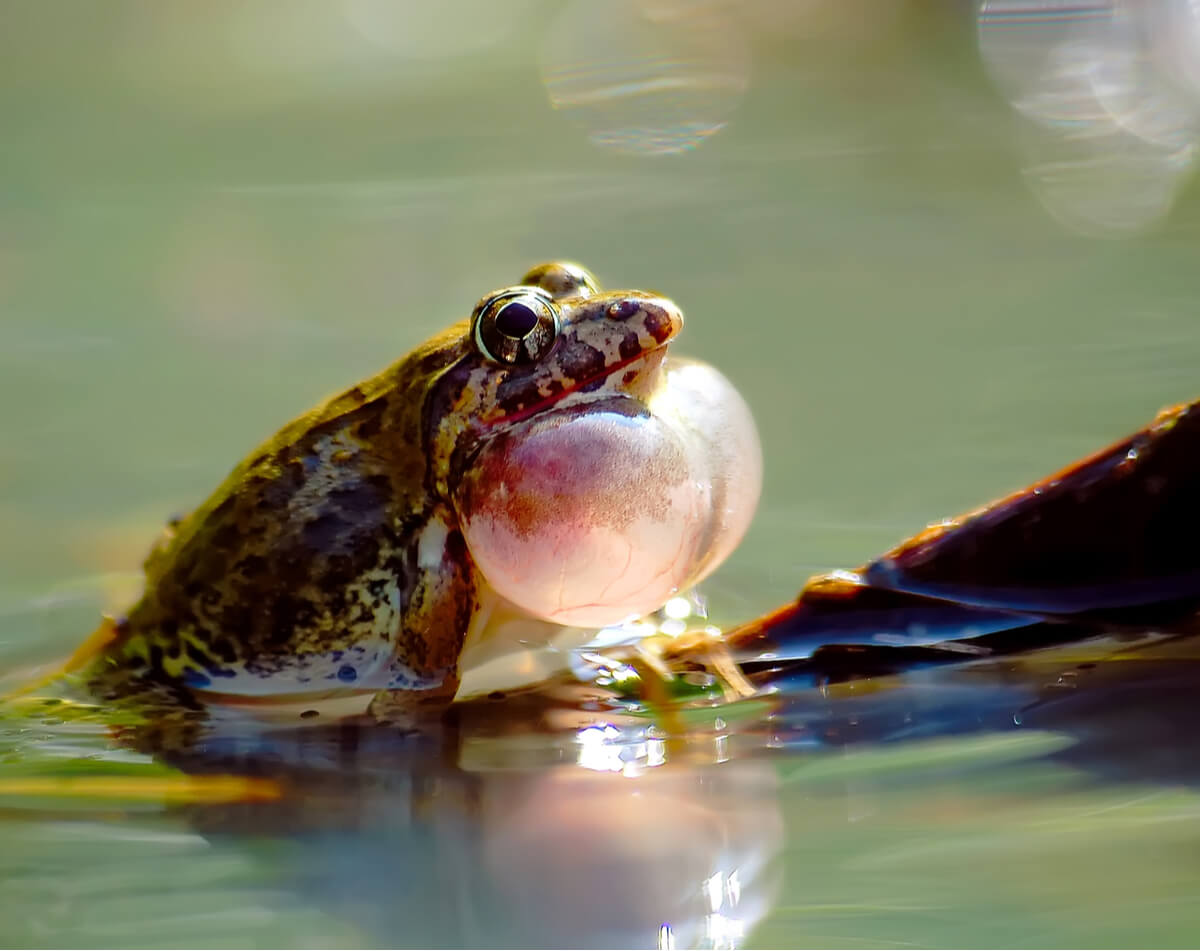Why Do Frogs Sing?


Written and verified by the biologist Samuel Sanchez
Frogs and other amphibians, just like the rest of the animals that inhabit the Earth, have a single vital purpose: reproduction. In order to do this, they have developed impressive phonic devices that produce songs of various tonalities and rhythms. So, how do frogs sing? What’s the purpose of these vocalizations? What kinds of songs do the most successful frogs make? If you want an answer to all these questions, keep reading.
Sexual selection
To understand the origin and motive of singing in frogs, we first need to understand the concept of sexual selection. This term is defined as a selective pressure, the result of competition between animals of a species, which doesn’t respond to the mechanisms of natural selection.
Natural selection is based on the survival of the species, and unsurprisingly, for example, a male peacock becomes a target with legs by displaying its feathers to attract a female. Yes, it draws the attention of its companion, but also of all the predators in the area.
This trade-off or commitment is explained by sexual selection. Males display their most striking characteristics to attract females even though this may cost them their lives. After all, what’s more important in nature than leaving offspring?

How and why do frogs sing?
Frog singing is a process that requires time, and above all, a lot of energy. To produce sounds, these tiny vertebrates push air from the lungs (through the larynx) into a specific oral cavity or mouth sac.
It’s surprising to know that in some species, the sound-producing musculature corresponds to 15% of the total mass of males, while it only represents 3% in females.
Studies show that these vocalizations don’t only expend an inordinate amount of energy, but also prevent males from feeding properly.
For example, males of the Eleutherodactylus coqui species seem to lose 16% of their body mass after the singing season. They’re too busy seeking the attention of females, because after all, what prevails in these choral environments is reproduction.
Types of sound interactions
Many frogs and toads have an explosive type of reproduction, as males and females arrive synchronously at the mating site and the episode lasts anything from a few hours to a few days.
In these cases, the pond becomes a battlefield. Males produce vocalizations to attract the attention of healthier and more vigorous females, but they also fight each other, pushing and, in many cases, separating others who are engaged in the act.
There are two types of sound interactions in frog and toad reproduction. They’re as follows:
Male-male competition
This is the most obvious song function. Male frogs and toads emit choral vocalizations in the reproduction area, but it’s curious to note that they do not interrupt each other. That is, they sing in turns!
The tone of the song, the number of repetitions, and its duration (among other patterns), can be indicative of the size and the state of health of the male. Thus, the female will have a predilection for dominant tones, as she naturally wants her offspring to be with the most suitable animal in the whole place.
The hues between frog species in the same geographic area are dramatically different. Nobody is interested in attracting the wrong species.
Male-female interaction
Not only males emit vocalizations. In some species of frogs, such as Limnonectes palavanensis, females also sing sporadically to attract the attention of males.
In other species, females have been observed to emit vocalizations in order to stimulate the sexual activity of their partners during copulation. Awesome, right?

The song of life
As we’ve seen, vocalizations in frogs and toads clearly respond to a selective pressure imposed by sexual selection. The best males will produce the most powerful songs, and, therefore, will be the ones that attract the attention of the females and copulate with them.
These mechanisms also protect the species in a general way. When all the males of a population flock to the same point, the possibility of being predated is reduced. The more individuals crowd into a single focus, the less likely it is that any one of them will be attacked.
Frogs and other amphibians, just like the rest of the animals that inhabit the Earth, have a single vital purpose: reproduction. In order to do this, they have developed impressive phonic devices that produce songs of various tonalities and rhythms. So, how do frogs sing? What’s the purpose of these vocalizations? What kinds of songs do the most successful frogs make? If you want an answer to all these questions, keep reading.
Sexual selection
To understand the origin and motive of singing in frogs, we first need to understand the concept of sexual selection. This term is defined as a selective pressure, the result of competition between animals of a species, which doesn’t respond to the mechanisms of natural selection.
Natural selection is based on the survival of the species, and unsurprisingly, for example, a male peacock becomes a target with legs by displaying its feathers to attract a female. Yes, it draws the attention of its companion, but also of all the predators in the area.
This trade-off or commitment is explained by sexual selection. Males display their most striking characteristics to attract females even though this may cost them their lives. After all, what’s more important in nature than leaving offspring?

How and why do frogs sing?
Frog singing is a process that requires time, and above all, a lot of energy. To produce sounds, these tiny vertebrates push air from the lungs (through the larynx) into a specific oral cavity or mouth sac.
It’s surprising to know that in some species, the sound-producing musculature corresponds to 15% of the total mass of males, while it only represents 3% in females.
Studies show that these vocalizations don’t only expend an inordinate amount of energy, but also prevent males from feeding properly.
For example, males of the Eleutherodactylus coqui species seem to lose 16% of their body mass after the singing season. They’re too busy seeking the attention of females, because after all, what prevails in these choral environments is reproduction.
Types of sound interactions
Many frogs and toads have an explosive type of reproduction, as males and females arrive synchronously at the mating site and the episode lasts anything from a few hours to a few days.
In these cases, the pond becomes a battlefield. Males produce vocalizations to attract the attention of healthier and more vigorous females, but they also fight each other, pushing and, in many cases, separating others who are engaged in the act.
There are two types of sound interactions in frog and toad reproduction. They’re as follows:
Male-male competition
This is the most obvious song function. Male frogs and toads emit choral vocalizations in the reproduction area, but it’s curious to note that they do not interrupt each other. That is, they sing in turns!
The tone of the song, the number of repetitions, and its duration (among other patterns), can be indicative of the size and the state of health of the male. Thus, the female will have a predilection for dominant tones, as she naturally wants her offspring to be with the most suitable animal in the whole place.
The hues between frog species in the same geographic area are dramatically different. Nobody is interested in attracting the wrong species.
Male-female interaction
Not only males emit vocalizations. In some species of frogs, such as Limnonectes palavanensis, females also sing sporadically to attract the attention of males.
In other species, females have been observed to emit vocalizations in order to stimulate the sexual activity of their partners during copulation. Awesome, right?

The song of life
As we’ve seen, vocalizations in frogs and toads clearly respond to a selective pressure imposed by sexual selection. The best males will produce the most powerful songs, and, therefore, will be the ones that attract the attention of the females and copulate with them.
These mechanisms also protect the species in a general way. When all the males of a population flock to the same point, the possibility of being predated is reduced. The more individuals crowd into a single focus, the less likely it is that any one of them will be attacked.
All cited sources were thoroughly reviewed by our team to ensure their quality, reliability, currency, and validity. The bibliography of this article was considered reliable and of academic or scientific accuracy.
- La selección sexual, investigaciónyciencia.com. Recogido a 10 de agosto en https://www.investigacionyciencia.es/blogs/medicina-y-biologia/5/posts/la-seleccin-sexual-ii-10141
- La selección sexual, understanding evolution. Recogido a 10 de agosto en https://evolution.berkeley.edu/evolibrary/article/0_0_0/evo_28_sp
- Woolbright, L. L., & Stewart, M. M. (1987). Foraging success of the tropical frog, Eleutherodactylus coqui: the cost of calling. Copeia, 69-75.
- Frog hearing and communication, Wikipedia. Recogido a 10 de agosto en https://en.wikipedia.org/wiki/Frog_hearing_and_communication#Sound_production
This text is provided for informational purposes only and does not replace consultation with a professional. If in doubt, consult your specialist.








